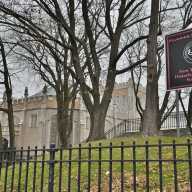Civic groups in Hillcrest are worried that a proposed mixed housing unit set to lodge individuals with chronic conditions will draw a “questionable population” next door.
Queens Hospital Center (QHC) is in talks with Comunilife, a nonprofit human services agency, to develop a deteriorated 10-story building on the hospital’s campus into 251 units of affordable, permanent supportive housing for individuals with chronic physical and mental health conditions, The Courier has learned.
Residency at the 82-68 164th Street site in Jamaica, called the “T-Building,” would be coupled with access to supportive health care services, including case workers, a hospital executive said. Apartment preference would be given to patients of Queens and Elmhurst Hospital Centers suffering from ailments including diabetes and chronic heart failure.
“It is our hope to ensure the reuse of this building for borough residents who have special needs, who have low incomes or who are veterans,” said Julius Wool, QHC’s executive director. “We look forward to being able to expand access to affordable housing options to Queens residents.”
QHC officials said it was too early to specify those “special needs,” but local civic associations said they expect masses of homeless people, the mentally ill, and individuals with HIV or AIDS, based on Comunilife’s mission statement to help that particular population.
“The overwhelming feeling is of great concern, if not rejection, of any consideration of this type of facility,” said Kevin Forrestal, president of the Hillcrest Estates Civic Association and area chair of Community Board 8. “We’re talking about a rather large number of people, hundreds, who are at risk, with mental issues.”
Forrestal said the hesitation stems from a “fear of crime or other offenses” the residents could potentially commit.
“Presumably, of most folks who have HIV, many, if not most, have had a history of drug abuse,” he said.
Bob Trabold, president of the Hillcrest-Jamaica Hill Neighborhood Association, shared the same sentiment, saying the project could be “threatening” to the neighborhood.
“There’s no supervision once residents leave the building,” he said. “What the hospital wants and what the neighborhood thinks is best may not be in harmony.”
The development’s close proximity to a nearby youth center and area high schools is reason for concern, too, according to the community leaders.
Wool said the approximate 230,000 square–foot dwelling would be for people with and without chronic illnesses and would help reduce emergency room use and hospital readmissions.
Costs have not yet been determined since the project is still in its preliminary stage, officials said, but funding for the anticipated multimillion dollar venture is expected to be secured early 2013.































